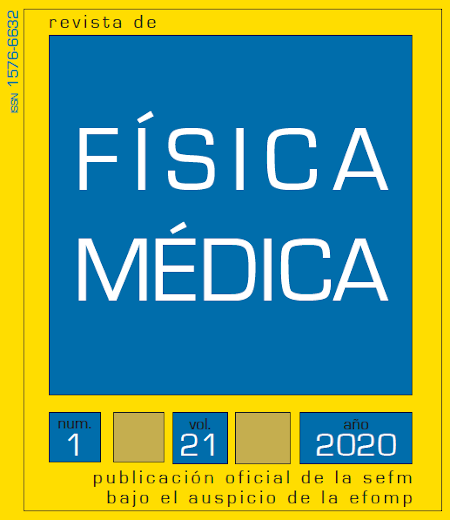A new adjustment proposal for determining tube output and analysis of its influence on mean glandular dose estimation
DOI:
https://doi.org/10.37004/sefm/2020.21.1.002Keywords:
Glandular dose, mammography, breast tomosynthesis, kerma, mammography dosimetersAbstract
The aim of this work is to propose a new polynomial fitting function to obtain air kerma for any kilovoltage in comparison to exponential fitting recommended by European and Spanish protocols. Kerma and half-value layer have been measured on three different mammography systems with an ionization chamber and a semiconductor dosimeter, in both digital mammography and digital breast tomosynthesis. Glandular dose has been estimated from these values using the method by Dance et al. The function proposed reveals a better agreement than the exponential one between measured and calculated kerma. Glandular dose estimation calculated from kerma by both exponential and polynomial function shows differences of less than 2.5% for all mammography systems using the ionization chamber, except for big breasts (bigger than 6 cm). Nevertheless, greater differences (~10%) are found between employed dosimeters. Therefore, knowing the dosimeters responses properly and using and accurate adjustment methodology is very important to minimize uncertainties in the glandular dose estimation.
References
Yaffe MJ, Mainprize JG. Risk of Radiation-induced Breast Cancer from Mammographic Screening. Radiology 2011; 258(1):98-105.
International Comission on Radiation Units and Measurements. Conversion coefficients for use in radiolo- gical protection against external radiation. ICRU report 74: Oxford University Press;2005.
International Comission on Radiological Protection. Statement from the 1987 Como Meeting of the ICRP . Publication 52: Pergamon Press;1987.
Dance DR. Monte Carlo calculation of conversion factors for the estimation of mean glandular breast dose. Phys Med Biol. 1990;35(9):1211-9.
Dance DR, Skinner CL, Young KC, Beckett JR, Kotre CJ. Additional factors for the estimation of mean glandular breast dose using the UK mammography dosimetry protocol. Phys Med Biol. 2000;45(11):3225-40.
Dance DR, Young KC, Van Engen RE. Further factors for the estimation of mean glandular dose using the United Kingdom, European and IAEA breast dosimetry protocols. Phys Med Biol. 2009; 54(14): 4361-4372.
Sobol WT, Wu X. Parametrization of mammography norma- lized average glandular dose tables. Med Phys. 1997;24(4): 547-54.
Boone JM. Normalized glandular dose (DgN) coefficients for arbitrary x-ray spectra in mammography: computer-fit values of Monte Carlo derived data. Med Phys. 2002;29(5): 869-75.
Castillo M, Garayoa J, Estrada C, Tejerina A, Benítez O, Alcazar A, et al. Tomosíntesis de mama: mamografía sinte- tizada versus mamografía digital. Impacto en la dosis. Rev Senol Patol Mamar. 2015; 28(1): 3-10.
Zuley M, Bandos A, Ganott M, Sumkin J, Kelly A, Catullo V, et al. Digital Breast Tomosynthesis versus supplemental diag- nostic mammographic views for evaluation of noncalcified breast lesions. Radiology. 2013;266(1):89-95.
Skaane P, Bandos A, Eben E, Jebsen I, Krager M, Haakenaasen U, et al. Two-view digital breast tomosynthesis screening with synthetically reconstructed projection images: comparison with digital breast tomosynthesis with full-field digital mammographic images. Radiology. 2014;271:655- 63.
Skaane P, Bandos A, Gulien R, Eben E, Ekseth U, Haakenaasen U et al. Comparison of digital mammography alone and digital mammography plus tomosynthesis in a population-based screening program. Radiology. 2013;267: 47-56.
Dance DR, Young KC, Van Engen RE. Estimation of mean glandular dose for breast tomosynthesis: Factors for use with the UK, European and IAEA breast dosimetry protocols. Phys Med Biol. 2011;56: 453-71.
Sechopoulos I, Sabol JM, Berglund J, Bolch WE, Brateman L, Christodoulou E et al. Radiation dosimetry in digi- tal breast tomosynthesis: Report of AAPM Tomosynthesis Subcommittee Task Group 223. Med Phys. 2014; 41(9):091501.
Sechopoulos I, Suryanarayanan S, Vedantham SC, Karellas A. Computation of the glandular radiation dose in digital tomosynthesis of the breast. Med Phys. 2007;34(1): 221-32.
Gennaro G, Avramova-Cholakova S, Azzalini A, Chapel ML, Chevalier M, Ciraj O, et al. Quality Controls in Digital Mammography protocol of the EFOMP MammoWorking group. Phys Medica. 2018;48:55-64.
S. Avramova-Cholakova S, Vassileva J, Borisova R, Atanasova I. An estimate of the influence of the measurement procedure on patient and phantom doses in breast imaging. Radiat Prot Dosimetry. 2008;129(1-3):150-4.
Robson K J. A parametric method for determining mammographic X-ray tube output and half value layer. Br J Radiol 74. 2001;335-40.
Nickoloff EL, Berman HL. Factors affecting X-ray Spectra. Radiographics. 1993;13(6):1337-48.
EFOMP Mammo Working Group. Quality Controls in Digital Mammography. 2015.
SEFM, SEPR, SERAM. Protocolo Español de Control de Calidad en Radiodiagnóstico. Revisión 2011. Madrid: Senda Editorial; 2012.
R.E. Van Engen RE, Bosmans H, Bouwman RW, Dance DR, Heid P, Lazzari B, et al. Protocol for the Quality Control of the Physical and Technical Aspects of Digital Breast Tomosynthesis Systems. Version 1.03. Nijmegen; 2018.
Burden RL, Faires DJ, Burden AM. Approximation theory. Numerical Analysis. 10th edition. Boston: Cengage Learning; 2016.








